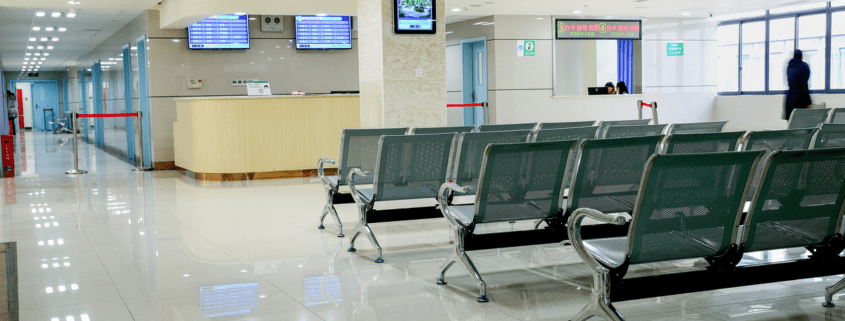4 Ways the Evolution of Healthcare Is Impacting Healthcare Real Estate
The healthcare industry is one of the fastest growing industries in the United States economy today, with a current value of over $1.2 trillion and a projected value of $5.7 trillion by 2026. An aging population and increasing spend on healthcare is driving a demand for more healthcare facilities, but the market is struggling to supply enough new construction. As the nations’ population grows, its citizens gradually age, and yearly total healthcare spending grows, the industry’s growth will continue to fuel a long-term demand for healthcare real estate.
Read ahead to learn about how the modern-day evolution of healthcare is driving new trends in commercial real estate.
The Gradual Shift to Outpatient Care
As evident in the name, outpatient care facilities have no overnight patients and are less expensive to build and operate than hospitals. Urgent care centers and ambulatory surgical centers are both examples of outpatient care facilities that have become more prevalent due to the minimization of building and operational expenses. According to CBRE, the number of outpatient centers jumped from 26,900 to 40,600 between 2005 and 2016 with no signs of slowing down. As the number of visits to and the demand for non-traditional healthcare facilities increases, many hospitals and health systems are being forced to reconfigure their footprints to include more outpatient medical offices. The evolution towards outpatient medical facilities is largely attributed to shifting patient preferences and technological innovations, both of which will only continue to evolve alongside the healthcare industry.
The Evolution of Patient Preferences
The United States population is predicted to gain about 79 million people by 2060, and in that same year 1 in 4 citizens are expected to be over the age of 65. As the population increases, current generations get older, and new generations emerge, patients’ preferences regarding their outpatient office visits are bound to change too. Driven by convenience, affordability, and the overall experience, patients have gradually become more discerning about how they are treated before, during, and after their appointments. Features such as a comfortable waiting room, flexible exam room space, and nature-inspired designs are now key to providing a better patient experience. Additionally, healthcare organizations have responded to patient demands for convenience and affordability by developing new construction in easily accessible and strategic locations near ambulatory and outpatient surgery centers and areas in close proximity to residential neighborhoods.
The Advancement of Healthcare Technology
Technology is a major driver in the evolution of healthcare real estate. Technology is increasing the efficiency healthcare facilities while decreasing the time it takes to complete paperwork, schedule appointments, perform procedures, and complete other critical yet time-consuming tasks. But as technology transforms the healthcare industry, it is also altering the real estate needs of providers. Increasingly, surgical procedures like hip and knee replacements are being completed more easily and quickly due to technology and are becoming outpatient surgeries that no longer require overnight stays. Additionally, the emergence of telemedicine, the practice of caring for patients remotely, has enabled doctors to consult patients by using HIPAA compliant video-conferencing tools. While programs like these allow medical facilities to reduce their wait times and serve more patients, technology-based improvements will certainly continue to have an impact on the number of physical hospitals needed as well as the amount of square-footage required to effectively operate a healthcare facility. In fact, Jefferson Health President and CEO, Steve Klasko, predicts that technology-driven efficiencies could increase so much that by 2028 the number of physical hospitals could be reduced by as much as 25% nationwide.
A Growing Investor Confidence in Medical Office Buildings
Healthcare real estate has grown exponentially with no signs of slowing down, and the most popular property type within this niche continues to be medical office buildings (MOBs). Several factors underpin the stability and success of this asset class. First, people will continue to need medical care, especially as Baby Boomers age and require more frequent and complex medical interventions to stay healthy. The ongoing need for treatment facilities insulates medical office buildings against market volatility, as demand is steady. Second, to keep healthcare costs low many people are choosing to go to smaller outpatient facilities because they are generally less expensive.
Investors are also drawn to the stability of this cycle-resistant market and its positive forecast for a continuously strong market performance. Rising 1.4% year over year to $22.90 per square foot, the average asking rent price for medical office buildings continue to climb and contribute to the growing investor confidence. Additionally, CBRE reported that medical office development is strongly correlated with population growth, further supporting the belief that medical office buildings will continue to have a longevity within the healthcare real estate industry.
What does this evolution mean for the future of healthcare real estate?
Employing more than 13% of the nation’s workforce and totaling almost $3.5 trillion in annual spending, healthcare remains one of the fastest growing industries. As the demand for healthcare continues to grow, real estate will have an important role in creating a more efficient, convenient, and accessible healthcare system. Real estate portfolios are anticipated to become more complex as outpatient care and medical office buildings evolve due to the healthcare industry’s accelerated growth. From investors seeking a recession-resistant investment to citizens searching for localized, affordable care, the healthcare real estate sector is positioned for unceasing future growth and expansion.
You may also be interested in 3 Factors Medical Office Buildings Need to Consider for Future Success.




